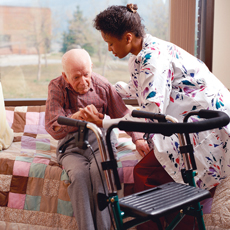
Elderly, dual-eligible Medicaid beneficiaries in long-term care settings aren’t more likely to be hospitalized than those receiving community-based care, even though long-term care residents tend to be older and have more chronic conditions.
Those are the findings of a group of researchers at the University of Chicago, who noted that care intensity and duration are more likely to suffer at the hands of untrained caregivers in non-facility settings.
The researchers reported that among people with dementia, home- and community-based service users actually had higher rates of hospitalizations than nursing home residents.
The study could be taken as proof that Medicaid’s shift toward community-based services — at the sacrifice of skilled nursing providers — may actually be detrimental to patients. Such practices may also underscore health disparities. Beneficiaries in certain racial and ethnic groups and sicker patients also were more likely to be hospitalized, according to the full study published in July’s issue of Health Affairs.
In 1996, only 19% of Medicaid long-term care expenditures were for HCBS, with the remaining 81% for nursing facilities, but by 2016, 57% went to HCBS, the researchers noted. To understand how that shift could be impacting patients, the team examined national claims data from 2012, the last year for which the Medicaid Analytic eXtract includes all states.
“The benefits of expanding funding for Medicaid long-term care home and community-based services relative to institutional care are often taken as self-evident,” the researchers wrote. “Our findings suggest that home and community-based services need to be carefully targeted to avoid adverse outcomes and that the racial/ethnic disparities in access to high-quality institutional long-term care are also present in (home-care settings).
“Policy makers should consider the full costs and benefits of shifting care from nursing facilities to home and community settings and the potential implications for equity.”
Home care overextension harm
The team found beneficiaries who used either institutional services or HCBS alone had similar rates of overall hospitalizations, even with the skilled nursing populations higher chronic conditions and higher mortality rates. Among people with dementia, hospitalization rates were higher among home-care users.
Also among home-care users, blacks were more likely to be hospitalized than non-Hispanic whites. Medicaid HCBS spending was also higher for whites than for nonwhites, and higher Medicare and Medicaid hospital spending for blacks and Hispanics did not offset this difference, the team reported.
“Home and community-based services generally entail lower-intensity care relative to the round-the-clock care available in a nursing facility,” said lead author Rebecca Gorges, a Ph.D. candidate in the Harris School of Public Policy. “Furthermore, they shift some of the care burden from trained, paid staff to largely untrained family members or friends, who must fill the critical gaps in care intensity.
“Home environments might not be safe or appropriately designed to accommodate needs, home care workers may face challenges implementing high-intensity treatments in the home environment, and informal caregivers might not be well trained to handle clinical issues. Thus, home and community-based services could lead to worse health outcomes relative to nursing facility care.”




